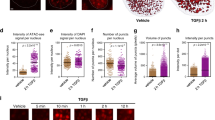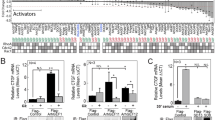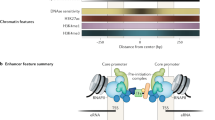Abstract
Epidermal growth factor receptor (EGFR) has been detected in the nucleus in many tissues and cell lines. However, the potential functions of nuclear EGFR have largely been overlooked. Here we demonstrate that nuclear EGFR is strongly correlated with highly proliferating activities of tissues. When EGFR was fused to the GAL4 DNA-binding domain, we found that the carboxy terminus of EGFR contained a strong transactivation domain. Moreover, the receptor complex bound and activated AT-rich consensus-sequence-dependent transcription, including the consensus site in cyclin D1 promoter. By using chromatin immunoprecipitation assays, we further demonstrated that nuclear EGFR associated with promoter region of cyclin D1 in vivo. EGFR might therefore function as a transcription factor to activate genes required for highly proliferating activities.
This is a preview of subscription content, access via your institution
Access options
Subscribe to this journal
Receive 12 print issues and online access
$209.00 per year
only $17.42 per issue
Buy this article
- Purchase on Springer Link
- Instant access to full article PDF
Prices may be subject to local taxes which are calculated during checkout







Similar content being viewed by others
References
Cohen, S., Ushiro, H., Stoscheck, C. & Chinkers, M. A native 170,000 epidermal growth factor receptor-kinase complex from shed plasma membrane vesicles. J. Biol. Chem. 257, 1523–1531 (1982).
Boonstra, J. et al. The epidermal growth factor. Cell. Biol. Int. 19, 413–30 (1995).
Anderson, D. et al. Binding of SH2 domains of phospholipase C γ1, GAP, and Src to activated growth factor receptors. Science 250, 979–982 (1990).
Hu, P. et al. Interaction of phosphatidylinositol 3-kinase-associated p85 with epidermal growth factor and platelet-derived growth factor receptors. Mol. Cell. Biol. 12, 981–990 (1992).
Carpenter, G. & Cohen, S. Epidermal growth factor. Annu. Rev. Biochem. 48, 193–216 (1979).
Knauer, D. J., Wiley, H. S. & Cunningham, D. D. Relationship between epidermal growth factor receptor occupancy and mitogenic response. Quantitative analysis using a steady state model system. J. Biol. Chem. 259, 5623–5631 (1984).
Defize, L. H., Moolenaar, W. H., van der Saag, P. T. & de Laat, S. W. Dissociation of cellular responses to epidermal growth factor using anti-receptor monoclonal antibodies. EMBO J. 5, 1187–1192 (1986).
Wakshull, E. M. & Wharton, W. Stabilized complexes of epidermal growth factor and its receptor on the cell surface stimulate RNA synthesis but not mitogenesis. Proc. Natl Acad. Sci. USA 82, 8513–8517 (1985).
Zimmermann, H. et al. The overexpression of proliferating cell nuclear antigen in biliary cirrhosis in the rat and its relationship with epidermal growth factor receptor. J. Hepatol. 23, 459–464 (1995).
Tervahauta, A., Syrjanen, S. & Syrjanen, K. Epidermal growth factor receptor, c-erbB-2 proto-oncogene and estrogen receptor expression in human papillomavirus lesions of the uterine cervix. Int. J. Gynecol. Pathol. 13, 234–240 (1994).
Kamio, T., Shigematsu, K., Sou, H., Kawai, K. & Tsuchiyama, H. Immunohistochemical expression of epidermal growth factor receptors in human adrenocortical carcinoma. Hum. Pathol. 21, 277–282 (1990).
Gusterson, B. et al. Evidence for increased epidermal growth factor receptors in human sarcomas. Int. J. Cancer 36, 689–693 (1985).
Lipponen, P. & Eskelinen, M. Expression of epidermal growth factor receptor in bladder cancer as related to established prognostic factors, oncoprotein (c-erbB-2, p53) expression and long-term prognosis. Br. J. Cancer 69, 1120–1125 (1994).
Pilch, P. F. & Czech, M. P. Interaction of cross-linking agents with the insulin effector system of isolated fat cells. Covalent linkage of 125I-insulin to a plasma membrane receptor protein of 140,000 daltons. J. Biol. Chem. 254, 3375–3381 (1979).
Rakowicz-Szulczynska, E. M., Rodeck, U., Herlyn, M. & Koprowski, H. Chromatin binding of epidermal growth factor, nerve growth factor, and platelet-derived growth factor in cells bearing the appropriate surface receptors. Proc. Natl Acad. Sci. USA 83, 3728–3732 (1986).
Khazaie, K., Schirrmacher, V. & Lichtner, R. B. EGF receptor in neoplasia and metastasis. Cancer Metastasis Rev. 12, 255–274 (1993).
Wright, W. E., Binder, M. & Funk, W. Cyclic amplification and selection of targets (CASTing) for the myogenin consensus binding site. Mol. Cell. Biol. 11, 4104–4110 (1991).
Kimura, H. Schwannoma-derived growth factor must be transported into the nucleus to exert its mitogenic activity. Proc. Natl Acad. Sci. USA 90, 2165–2169 (1993).
Jans, D. A. & Hassan, G. Nuclear targeting by growth factors, cytokines, and their receptors: a role in signaling? BioEssays 20, 400–411 (1998).
Vigneri, R., Goldfine, I. D., Wong, K. Y., Smith, G. J. & Pezzino, V. The nuclear envelope. The major site of insulin binding in rat liver nuclei. J. Biol. Chem. 253, 2098–2103 (1978).
Rakowicz-Szulczynska, E. M., Herlyn, M. & Koprowski, H. Nerve growth factor receptors in chromatin of melanoma cells, proliferating melanocytes, and colorectal carcinoma cells in vitro. Cancer Res. 48, 7200–7206 (1988).
Maher, P. A. Nuclear translocation of fibroblast growth factor (FGF) receptors in response to FGF-2. J. Cell Biol. 134, 529–536 (1996).
Stachowiak, M. K., Maher, P. A., Joy, A., Mordechai, E. & Stachowiak, E. K. Nuclear accumulation of fibroblast growth factor receptors is regulated by multiple signals in adrenal medullary cells. Mol. Biol. Cell 7, 1299–1317 (1996).
Lobie, P. E., Wood, T. J., Chen, C. M., Waters, M. J. & Norstedt, G. Nuclear translocation and anchorage of the growth hormone receptor. J. Biol. Chem. 269, 31735–31746 (1994).
Curtis, B. M., Widmer, M. B., deRoos, P. & Qwarnstrom, E. E. IL-1 and its receptor are translocated to the nucleus. J. Immunol. 144, 1295–1303 (1990).
Srinivasan, R., Gillett, C. E., Barnes, D. M. & Gullick, W. J. Nuclear expression of the c-erbB-4/HER-4 growth factor receptor in invasive breast cancers. Cancer Res. 60, 1483–1487 (2000).
Xie, Y. & Hung, M. C. Nuclear localization of p185neu tyrosine kinase and its association with transcriptional transactivation. Biochem. Biophys. Res. Commun. 203, 1589–1598 (1994).
Cohen, J. A., Yachnis, A. T., Arai, M., Davis, J. G. & Scherer, S. S. Expression of the neu proto-oncogene by Schwann cells during peripheral nerve development and Wallerian degeneration. J. Neurosci. Res. 31, 622–634 (1992).
Hsu, S. M., Raine, L. & Fanger, H. Use of avidin–biotin–peroxidase complex (ABC) in immunoperoxidase techniques: a comparison between ABC and unlabeled antibody (PAP) procedures. J. Histochem. Cytochem. 29, 577–580 (1981).
Braunstein, M., Rose, A. B., Holmes, S. G., Allis, C. D. & Broach, J. R. Transcriptional silencing in yeast is associated with reduced nucleosome acetylation. Genes Dev. 7, 592–604 (1993).
Orlando, V. & Paro, R. Mapping Polycomb-repressed domains in the bithorax complex using in vivo formaldehyde cross-linked chromatin. Cell 75, 1187–1198 (1993).
Acknowledgements
We thank You-Wei Chen for his assistance with the confocal microscopic analysis. The work was supported partly by NCI grants (to L.B. and M.-C.H.), an M.D. Anderson Faculty Achievement Award (to M.-C.H.) and a predoctoral fellowship from the DOD Breast Cancer Research Program (to S.-Y. L.). K.M. and Y.W. are supported by a DOD Breast Cancer Research Training Grant.
Author information
Authors and Affiliations
Corresponding author
Rights and permissions
About this article
Cite this article
Lin, SY., Makino, K., Xia, W. et al. Nuclear localization of EGF receptor and its potential new role as a transcription factor. Nat Cell Biol 3, 802–808 (2001). https://doi.org/10.1038/ncb0901-802
Received:
Revised:
Accepted:
Published:
Issue Date:
DOI: https://doi.org/10.1038/ncb0901-802
This article is cited by
-
Sorting nexin-dependent therapeutic targeting of oncogenic epidermal growth factor receptor
Cancer Gene Therapy (2023)
-
Nucleocytoplasmic transport of active HER2 causes fractional escape from the DCIS-like state
Nature Communications (2023)
-
D-mannose induces TFE3-dependent lysosomal degradation of EGFR and inhibits the progression of NSCLC
Oncogene (2023)
-
PTPN23 ubiquitination by WDR4 suppresses EGFR and c-MET degradation to define a lung cancer therapeutic target
Cell Death & Disease (2023)
-
ERBB Receptors and Their Ligands in the Developing Mammary Glands of Different Species: Fifteen Characters in Search of an Author
Journal of Mammary Gland Biology and Neoplasia (2023)



